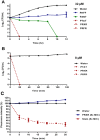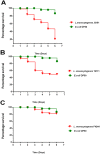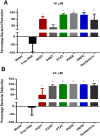Impact of different cell penetrating peptides on the efficacy of antisense therapeutics for targeting intracellular pathogens
- PMID: 26860980
- PMCID: PMC4748415
- DOI: 10.1038/srep20832
Impact of different cell penetrating peptides on the efficacy of antisense therapeutics for targeting intracellular pathogens
Abstract
There is a pressing need for novel and innovative therapeutic strategies to address infections caused by intracellular pathogens. Peptide nucleic acids (PNAs) present a novel method to target intracellular pathogens due to their unique mechanism of action and their ability to be conjugated to cell penetrating peptides (CPP) to overcome challenging delivery barriers. In this study, we targeted the RNA polymerase α subunit (rpoA) using a PNA that was covalently conjugated to five different CPPs. Changing the conjugated CPP resulted in a pronounced improvement in the antibacterial activity observed against Listeria monocytogenes in vitro, in cell culture, and in a Caenorhabditis elegans (C. elegans) infection model. Additionally, a time-kill assay revealed three conjugated CPPs rapidly kill Listeria within 20 minutes without disrupting the bacterial cell membrane. Moreover, rpoA gene silencing resulted in suppression of its message as well as reduced expression of other critical virulence genes (Listeriolysin O, and two phospholipases plcA and plcB) in a concentration-dependent manner. Furthermore, PNA-inhibition of bacterial protein synthesis was selective and did not adversely affect mitochondrial protein synthesis. This study provides a foundation for improving and developing PNAs conjugated to CPPs to better target intracellular pathogens.
Figures





Similar articles
-
Targeting listeria monocytogenes rpoA and rpoD genes using peptide nucleic acids.Nucleic Acid Ther. 2013 Oct;23(5):363-7. doi: 10.1089/nat.2013.0426. Epub 2013 Jul 16. Nucleic Acid Ther. 2013. PMID: 23859300 Free PMC article.
-
PNA-based antisense oligonucleotides for micrornas inhibition in the absence of a transfection reagent.Oligonucleotides. 2010 Oct;20(5):225-30. doi: 10.1089/oli.2010.0238. Epub 2010 Oct 14. Oligonucleotides. 2010. PMID: 20946011
-
Improved cellular uptake of antisense peptide nucleic acids by conjugation to a cell-penetrating peptide and a lipid domain.Methods Mol Biol. 2011;751:209-21. doi: 10.1007/978-1-61779-151-2_13. Methods Mol Biol. 2011. PMID: 21674333
-
Developments in Cell-Penetrating Peptides as Antiviral Agents and as Vehicles for Delivery of Peptide Nucleic Acid Targeting Hepadnaviral Replication Pathway.Biomolecules. 2018 Jul 16;8(3):55. doi: 10.3390/biom8030055. Biomolecules. 2018. PMID: 30013006 Free PMC article. Review.
-
Peptide nucleic acid conjugates and their antimicrobial applications-a mini-review.Eur Biophys J. 2023 Oct;52(6-7):533-544. doi: 10.1007/s00249-023-01673-w. Epub 2023 Aug 23. Eur Biophys J. 2023. PMID: 37610696 Free PMC article. Review.
Cited by
-
Identifying Cell-Penetrating Peptides for Effectively Delivering Antimicrobial Molecules into Streptococcus suis.Antibiotics (Basel). 2024 Aug 2;13(8):725. doi: 10.3390/antibiotics13080725. Antibiotics (Basel). 2024. PMID: 39200025 Free PMC article.
-
An Efficient Approach for the Design and Synthesis of Antimicrobial Peptide-Peptide Nucleic Acid Conjugates.Front Chem. 2022 Mar 15;10:843163. doi: 10.3389/fchem.2022.843163. eCollection 2022. Front Chem. 2022. PMID: 35372270 Free PMC article.
-
Global RNA profiles show target selectivity and physiological effects of peptide-delivered antisense antibiotics.Nucleic Acids Res. 2021 May 7;49(8):4705-4724. doi: 10.1093/nar/gkab242. Nucleic Acids Res. 2021. PMID: 33849070 Free PMC article.
-
Antisense antimicrobial therapeutics.Curr Opin Microbiol. 2016 Oct;33:47-55. doi: 10.1016/j.mib.2016.05.017. Epub 2016 Jun 29. Curr Opin Microbiol. 2016. PMID: 27375107 Free PMC article. Review.
-
Pyrenebutyrate Enhances the Antibacterial Effect of Peptide-Coupled Antisense Peptide Nucleic Acids in Streptococcus pyogenes.Microorganisms. 2023 Aug 22;11(9):2131. doi: 10.3390/microorganisms11092131. Microorganisms. 2023. PMID: 37763975 Free PMC article.
References
Publication types
MeSH terms
Substances
LinkOut - more resources
Full Text Sources
Other Literature Sources
Molecular Biology Databases

